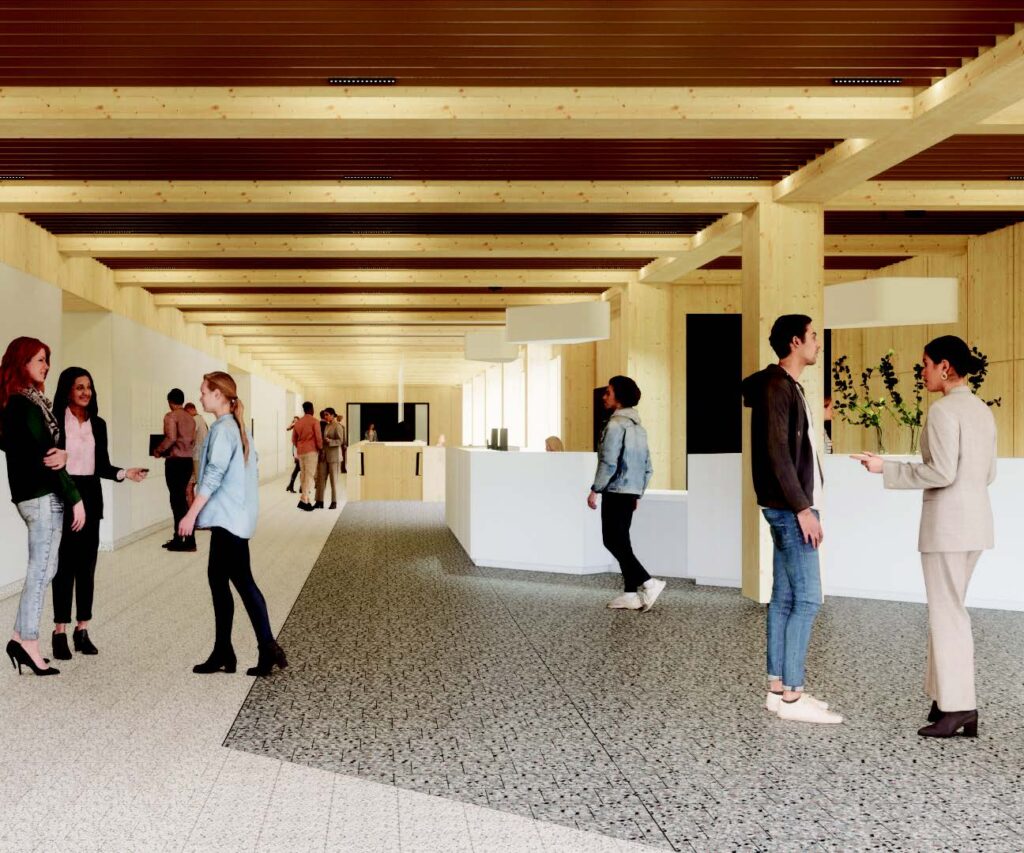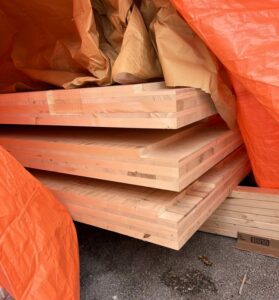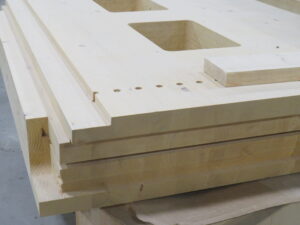
When the new Lawson Centre for Sustainability opens in 2025, it will usher in an exciting new chapter for Trinity. As a living example of what can be achieved with a core commitment to sustainability, the new building will shape the values of all who live, learn, grow, eat, and connect within it.
Even in planning, Trinity demanded a building that set new standards. The Lawson Centre for Sustainability is unique in combining so many sustainability features in a single structure—one of which is the use of mass timber.
“From our earliest discussions we knew this had to be an innovative sustainability building. The best way to achieve that is through mass timber,” says Jonathan Steels, Trinity’s Assistant Provost.
What is mass timber?
Mass timber is an engineered wood product where multiple solid wood strips or panels are glued or nailed together to create a strong, fire-resistant, building material that’s even stronger than concrete.
The Lawson Centre for Sustainability will be a hybrid mass timber and concrete structure that incorporates glulam beams and CLT (see “Terms to know” for definitions), with concrete in the foundation, elevator cores and stairwells, and anchoring major timber structural elements.
While we are all familiar with wooden houses, using wood in a multi-storey building is new. Popular in Europe for decades, mass timber is becoming more widely used in North America, offering a low-carbon alternative to traditional steel and concrete buildings.

TERMS TO KNOW
Mass timber: Engineered wood products made of large, solid wood panels, columns or beams for use as load-bearing wall, floor and roof assemblies. Typically formed and engineered for high strength through lamination, fasteners or structural adhesives. Types of mass timber include CLT, Glulam, NLT (nail-laminated timber) and DLT (dowel-laminated timber).
CLT (cross-laminated timber): Wood panels formed by gluing together multiple layers of wood oriented at right angles to one another. Strong, stable and rigid, it is used in mid- and high-rise construction.
Glulam (glue-laminated timber): Allows for long spans of exposed framing. Most often used for structural beams and columns.
Biophilic design: Incorporating natural elements including plants, exposed wood, water, natural light and views of nature into a built environment to boost the well-being of its occupants.
LEED Platinum: LEED (Leadership in Energy and Environmental Design) is the world’s most widely used green building rating system, and is a globally recognized symbol of sustainability achievement. Platinum is the highest of four levels of LEED certification.
Zero-carbon: A zero-carbon building is highly energy-efficient and minimizes greenhouse gas emissions in its operation as well as its building materials.
Why Trinity chose mass timber
Mass timber’s appeal as a sustainable building material begins with production and transportation, and extends to aesthetics and the ease of construction.
First, trees are a renewable resource in which Canada is rich, so at its core the timber is sustainable. The College has also sourced materials hyper-locally, reducing costs and emissions: The mass timber for the Lawson Centre for Sustainability comes from St. Thomas, Ontario, just 200 kilometres west of the College. (Even the limestone and brick cladding are from Cambridge, 100 kilometres away.)
Second, wood products create far fewer carbon emissions during manufacturing—especially when compared with steel, which a recent McKinsey report described as a “carbon mega-producer” due to energy use in production. Trees are also a “carbon sink,” capturing carbon dioxide from the atmosphere as they grow, sequestering thousands of tons of CO2. That carbon is stored for the life of the wood.
Third, construction time using mass timber is typically more efficient (some estimate 25 per cent faster) than using traditional concrete and steel. Because prefabrication of larger elements takes place offsite, larger segments arrive on site ready for installation, making the construction process seem more like building with Lego.
“After the first hoist of the mass timber in February, we can expect each of the four storeys of the east wing to take a week to assemble, so we’ll be able to see the exoskeleton of that wing within about a month,” says Gregor Browning, Special Projects Officer at Trinity College, who is coordinating the construction of the new building with project partners.
Finally, there may be significant health benefits to building with natural wood. A growing body of research proves that biophilic design—one that incorporates natural elements into an indoor space—improves occupants’ mood, concentration and productivity, and reduces stress.
Leading by example
Bringing this innovative building to life is not without its hurdles. Insurance took longer because policies are being written from scratch for this relatively new category. The Lawson Centre for Sustainability is one of the first uses of mass timber for residential construction. “Even the permitting process with the City required an innovative approach, as we were required to submit an Alternative Solutions application as part of our building permit,” says Browning. “Mass timber construction falls outside the existing building code in some areas, and we had to prove to the City that this project was viable, particularly from a structural and fire protection standpoint.” At every step, Trinity remained committed to putting sustainability first.
Says Trinity Provost Mayo Moran, “The Lawson Centre for Sustainability will help to show what is possible and clear the way for others, which is one of our overarching goals. An important part of Trinity’s big-picture commitment to sustainability involves setting an example that makes it easier to adopt mass timber and sustainable construction. We’re very proud of this leading-edge building, which will be a beautiful example of sustainable architecture for Trinity College and the University of Toronto.”
As part of its commitment to sustainability in every aspect, Trinity will seek LEED Platinum certification as well as zero-carbon status (see sidebar) for the Lawson Centre for Sustainability. From photovoltaic panels to geothermal heat pumps to an urban farm to green roof sections and mass timber, every aspect of this new hub for the Trinity community has been thoughtfully planned to truly embody sustainability (learn more about sustainability and Trinity here).
By Jennifer Matthews


Sorry, comments are closed for this post.